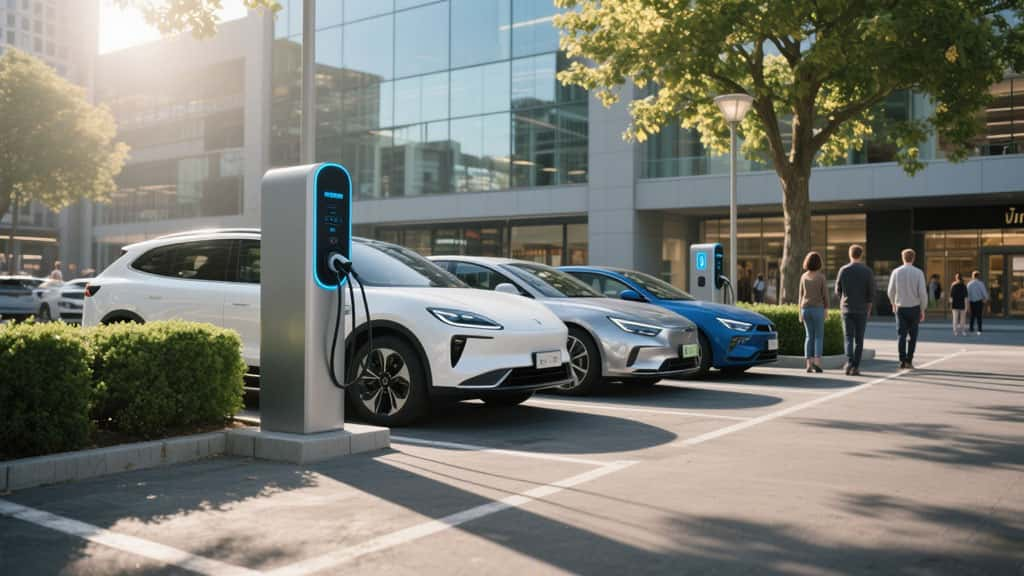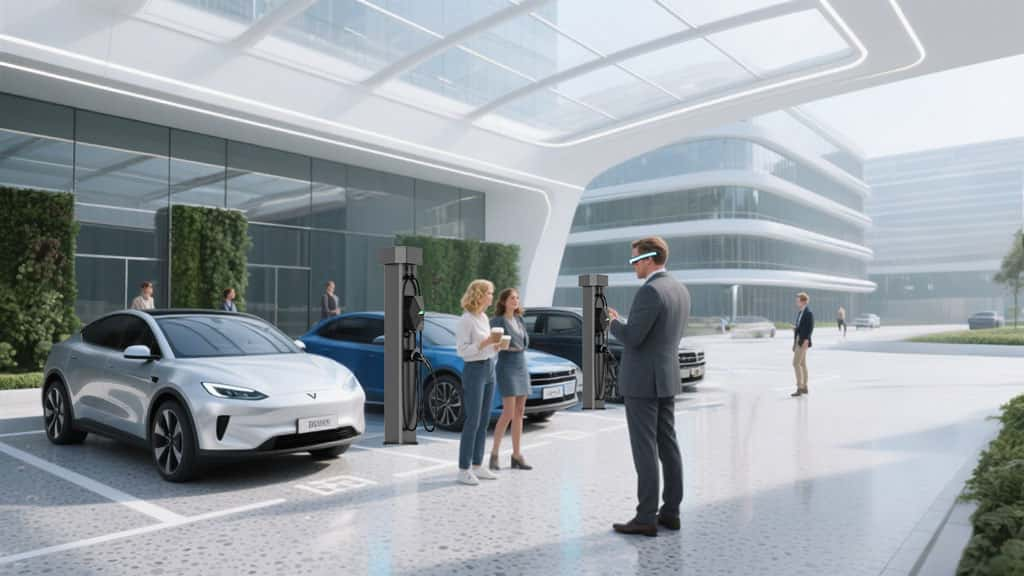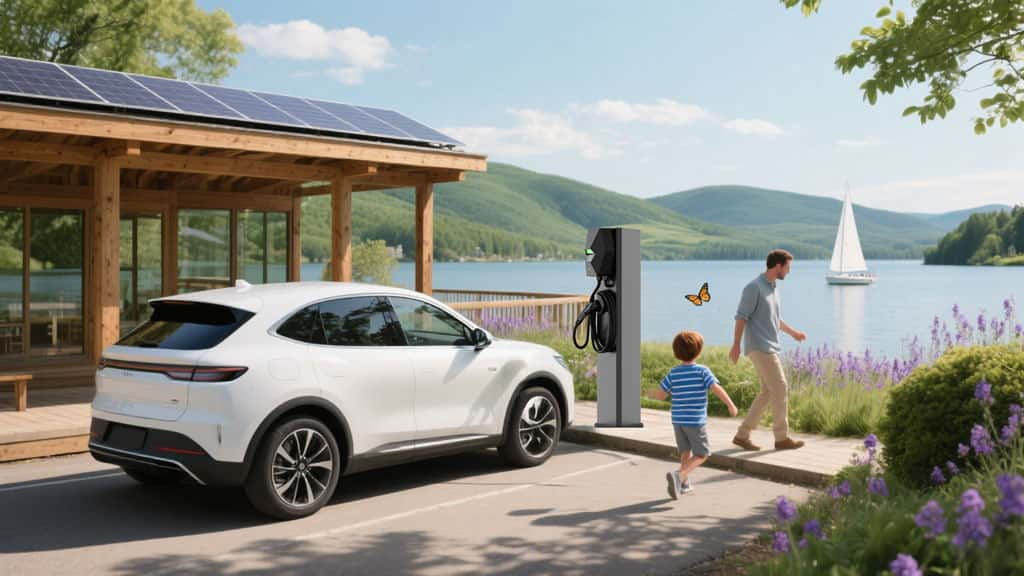The popularization of electric vehicles (EVs) is accelerating, with millions of car owners worldwide enjoying cleaner, more efficient modes of transportation. As the number of EVs surges, the demand for charging infrastructure is growing rapidly. Among various charging methods, EV destination charging is emerging as a crucial solution. It's not just about charging electric vehicles; it's a new lifestyle and a significant business opportunity.
EV destination charging allows car owners to charge their vehicles after reaching their final destination, during the time the vehicle is parked. Imagine your EV quietly recharging while you stay at a hotel overnight, shop at a mall, or enjoy a meal at a restaurant. This model greatly enhances the convenience of electric vehicles, effectively alleviating the "range anxiety" that many EV owners commonly experience. It integrates charging into daily activities, making electric mobility seamless and effortless. This article will delve into all aspects of EV destination charging, including its definition, applicable scenarios, business value, implementation guidelines, and future development trends.
I. What is EV Destination Charging?
Electric vehicle charging methods are diverse, but EV destination charging has its unique positioning and advantages. It refers to electric vehicle owners charging their vehicles after arriving at a destination, utilizing the opportunity of prolonged parking. This is similar to "home charging" but the location shifts to public or semi-public places.
Characteristics:
•Extended Stay: Destination charging typically occurs at locations where vehicles are parked for several hours or even overnight, such as hotels, shopping malls, restaurants, tourist attractions, or workplaces.
•Primarily L2 AC Charging: Due to the longer stay, destination charging usually employs Level 2 (L2) AC charging piles. L2 chargers provide a relatively slower but stable charging speed, sufficient to fully charge a vehicle or significantly extend its range within a few hours. Compared to DC fast charging (DCFC), the charging station cost of L2 chargers is generally lower, and installation is simpler.
•Integration with Daily Life Scenarios: The appeal of destination charging lies in the fact that it doesn't require extra time. Vehicle owners can charge their cars while engaging in their daily activities, achieving the convenience of "charging as part of life."
Importance:
EV destination charging is crucial for the popularization of electric vehicles. While home charging is the preferred option for many EV owners, not everyone has the conditions to install a home charger. Furthermore, for long-distance trips or errands, destination charging effectively supplements the shortcomings of home charging. It alleviates owners' concerns about not finding charging points, enhancing the overall convenience and attractiveness of electric vehicles. This model not only makes EVs more practical but also brings new opportunities for commercial establishments.
II. Applicable Scenarios and Value of Destination Charging
The flexibility of EV destination charging makes it suitable for various commercial and public places, creating a win-win situation for venue providers and EV owners.
1. Hotels and Resorts
For hotels and resorts, providing EV destination charging services is no longer an option but a crucial way to attract new customers and enhance customer satisfaction.
•Attract EV Owners: A growing number of EV owners consider charging facilities an important factor when booking accommodation. Offering charging services can make your hotel stand out from the competition.
•Increase Occupancy Rates and Customer Satisfaction: Imagine a long-distance EV traveler arriving at a hotel and finding they can easily charge their vehicle – this will undoubtedly greatly enhance their stay experience.
•As a Value-Added Service: Free charging services can be offered as a perk or an additional paid service, bringing new revenue streams to the hotel and enhancing its brand image.
•Case Studies: Many boutique and chain hotels have already made EV charging a standard amenity and use it as a marketing highlight.
2. Retailers and Shopping Centers
Shopping centers and large retail stores are places where people spend extended periods, making them ideal for deploying EV destination charging.
•Extend Customer Stay, Increase Spending: Customers, knowing their cars are charging, may be more willing to stay longer in the mall, thereby increasing shopping and spending.
•Attract New Consumer Groups: EV owners are often environmentally conscious and have higher spending power. Providing charging services can effectively attract this demographic.
•Enhance Mall Competitiveness: Among similar malls, those offering charging services are undoubtedly more attractive.
•Plan Charging Parking Spaces: Reasonably plan charging parking spaces and set up clear signs to guide consumers to easily find charging points.
3. Restaurants and Leisure Venues
Providing charging services at restaurants or leisure venues can offer unexpected convenience to customers.
•Enhance Customer Experience: Customers can recharge their vehicles while enjoying food or entertainment, improving overall convenience and satisfaction.
•Attract Repeat Customers: A positive charging experience will encourage customers to return.
4. Tourist Attractions and Cultural Facilities
For tourist attractions and cultural facilities that draw visitors, EV destination charging can effectively solve the long-distance travel charging pain point.
•Support Green Tourism: Encourage more EV owners to choose your attraction, aligning with sustainable development principles.
•Expand Visitor Reach: Alleviate range anxiety for long-distance travelers, attracting visitors from further away.
5. Workplaces and Business Parks
Workplace EV Charging is becoming a significant benefit for modern businesses to attract and retain talent.
•Provide Convenience for Employees and Visitors: Employees can charge their vehicles during work hours, eliminating the hassle of finding charging points after work.
•Demonstrate Corporate Social Responsibility: Deploying charging facilities reflects a company's commitment to environmental protection and employee well-being.
•Enhance Employee Satisfaction: Convenient charging services are an important component of employee benefits.
6. Multi-Family Residences and Apartments
For apartment buildings and multi-family residences, providing EV Charging for Multifamily Properties is crucial for meeting residents' growing charging needs.
•Meet Resident Charging Needs: As EVs become more popular, more residents need to charge near home.
•Increase Property Value: Apartments with charging facilities are more attractive and can increase the rental or sales value of the property.
•Plan and Manage Shared Charging Facilities: This may involve complex EV charging station design and EV charging load management, requiring professional solutions to ensure fair use and efficient management.
III. Commercial Considerations and Implementation Guidelines for Deploying EV Destination Charging
Successful deployment of EV destination charging requires meticulous planning and a deep understanding of commercial factors.
1. Return on Investment (ROI) Analysis
Before deciding to invest in an EV destination charging project, a detailed ROI analysis is crucial.
•Initial Investment Costs:
•Electric Vehicle Supply Equipment (EVSE) procurement costs: The cost of the charging piles themselves.
•Installation costs: Including wiring, piping, civil works, and labor fees.
•Grid upgrade costs: If the existing electrical infrastructure is insufficient, upgrades may be required.
•Software and management system fees: Such as fees for the Charge Point Operator platform.
•Operating Costs:
•Electricity costs: The cost of power consumed for charging.
•Maintenance costs: Routine inspection, repair, and upkeep of equipment.
•Network connectivity fees: For communication of the smart charging management system.
•Software service fees: Ongoing platform subscription fees.
•Potential Revenue:
•Charging service fees: Fees charged to users for charging (if a paid model is chosen).
•Value added from attracting customer traffic: For example, increased spending due to extended customer stay at shopping malls, or higher occupancy rates at hotels.
•Enhanced brand image: Positive publicity as an environmentally friendly enterprise.
Comparison of Profitability Across Different Business Models:
| Business Model | Advantages | Disadvantages | Applicable Scenarios |
| Free Provision | Greatly attracts customers, boosts satisfaction | No direct revenue, costs borne by the venue | Hotels, high-end retail, as a core value-added service |
| Time-Based Charging | Simple and easy to understand, encourages short stays | May lead to users paying for waiting time | Parking lots, public spaces |
| Energy-Based Charging | Fair and reasonable, users pay for actual consumption | Requires more precise metering systems | Most commercial charging stations |
| Membership/Package | Stable revenue, cultivates loyal customers | Less attractive to non-members | Business parks, apartments, specific member clubs |
2. Charging Pile Selection and Technical Requirements
Choosing the appropriate Electric Vehicle Supply Equipment (EVSE) is crucial for successful deployment.
•L2 AC Charging Pile Power and Interface Standards: Ensure the charging pile's power meets demand and supports mainstream charging interface standards (e.g., National Standard, Type 2).
•Importance of Smart Charging Management System (CPMS):
•Remote Monitoring: Real-time viewing of charging pile status and remote control.
•Payment Management: Integration of various payment methods to facilitate users to Pay for EV Charging.
•User Management: Registration, authentication, and billing management.
•Data Analysis: Charging data statistics and report generation to provide a basis for operational optimization.
•Consider Future Scalability and Compatibility: Choose an upgradeable system to adapt to future electric vehicle technologies and charging standard changes.
3. Installation and Infrastructure Construction
EV charging station design is the foundation for ensuring efficient and safe operation of charging stations.
•Site Selection Strategy:
•Visibility: Charging stations should be easy to find, with clear signage.
•Accessibility: Convenient for vehicles to enter and exit, avoiding congestion.
•Safety: Good lighting and surveillance to ensure user and vehicle safety.
•Power Capacity Assessment and Upgrades: Consult a professional electrician to assess whether the existing electrical infrastructure can support the added charging load. Upgrade the power grid if necessary.
•Construction Procedures, Permits, and Regulatory Requirements: Understand local building codes, electrical safety standards, and permits for charging facility installation.
•Parking Space Planning and Identification: Ensure sufficient charging parking spaces and clear "EV Charging Only" signs to prevent occupancy by gasoline vehicles.
4. Operation and Maintenance
Efficient operation and regular maintenance are key to ensuring the quality of EV destination charging services.
•Daily Maintenance and Troubleshooting: Regularly check the operating status of charging piles, promptly handle faults, and ensure charging piles are always available.
•Customer Support and Service: Provide 24/7 customer support hotlines or online services to answer user questions and resolve charging issues.
•Data Monitoring and Performance Optimization: Utilize CPMS to collect charging data, analyze usage patterns, optimize charging strategies, and improve charging pile utilization.
IV. Optimizing EV Destination Charging User Experience
An excellent user experience is at the core of successful EV destination charging.
1. Charging Navigation and Information Transparency
•Integrate with Mainstream Charging Apps and Map Platforms: Ensure your charging station information is listed and updated in mainstream EV navigation apps and charging maps (e.g., Google Maps, Apple Maps, ChargePoint), to avoid wasted trips.
•Real-time Display of Charging Pile Status: Users should be able to view the real-time availability of charging piles (available, occupied, out of order) via apps or websites.
•Clear Charging Standards and Payment Methods: Clearly display charging fees, billing methods, and supported payment options on the charging piles and in the apps, so users can pay with full understanding.
2. Convenient Payment Systems
•Support Multiple Payment Methods: In addition to traditional card payments, it should also support mainstream credit/debit cards (Visa, Mastercard, American Express), mobile payments (Apple Pay, Google Pay), charging app payments, RFID cards, and Plug & Charge, among others.
•Seamless Plug-and-Charge Experience: Ideally, users should simply plug in the charging gun to start charging, with the system automatically identifying and billing.
3. Safety and Convenience
•Lighting, Surveillance, and Other Safety Facilities: Especially at night, adequate lighting and video surveillance can enhance users' sense of security while charging.
•Surrounding Amenities: Charging stations should have nearby convenience stores, rest areas, restrooms, Wi-Fi, and other facilities, allowing users to have things to do while waiting for their vehicle to charge.
•Charging Etiquette and Guidelines: Set up signs to remind users to move their vehicles promptly after charging is complete, to avoid occupying charging spaces, and to maintain good charging order.
4. Addressing Range Anxiety
EV destination charging is an effective way to alleviate EV owners' "range anxiety." By providing reliable charging services at locations where people spend extended periods, vehicle owners can plan their trips with greater confidence, knowing they can find convenient charging points wherever they go. Combined with EV charging load management, power can be distributed more effectively, ensuring more vehicles can charge simultaneously, further alleviating anxiety.
V. Policies, Trends, and Future Outlook
The future of EV destination charging is full of opportunities, but also faces challenges.
1. Government Incentives and Subsidies
Governments worldwide are actively promoting EV adoption and have introduced various policies and subsidies to encourage the construction of EV destination charging infrastructure. Understanding and leveraging these policies can significantly reduce initial investment costs.
2. Industry Trends
•Intelligentization and V2G (Vehicle-to-Grid) Technology Integration: Future charging piles will not only be charging devices but will also interact with the power grid, enabling bidirectional energy flow to help the grid balance peak and off-peak loads.
•Integration with Renewable Energy: More charging stations will integrate renewable energy sources like solar and wind power to achieve truly green charging.
•Interconnectivity of Charging Networks: Cross-platform and cross-operator charging networks will become more prevalent, enhancing user experience.
3. Challenges and Opportunities
•Grid Capacity Challenges: Large-scale deployment of charging piles may put pressure on existing power grids, requiring intelligent EV charging load management systems to optimize power distribution.
•Diversification of User Needs: As EV types and user habits change, charging services need to become more personalized and flexible.
•Exploration of New Business Models: Innovative models such as shared charging and subscription services will continue to emerge.
VI. Conclusion
EV destination charging is an indispensable part of the electric vehicle ecosystem. It not only brings unprecedented convenience to EV owners and effectively alleviates range anxiety, but more importantly, it offers immense opportunities for various commercial establishments to attract customers, enhance service quality, and create new revenue streams.
As the global electric vehicle market continues to grow, the demand for EV destination charging infrastructure will only increase. Actively deploying and optimizing destination charging solutions is not just about seizing market opportunities; it's also about contributing to sustainable development and green mobility. Let us collectively look forward to and build a more convenient and intelligent future for electric mobility.
As a leading manufacturer in the EV charging industry, Elinkpower offers a comprehensive range of L2 EV Charger products designed to meet the diverse hardware needs of various destination charging scenarios. From hotels and retailers to multi-family properties and workplaces, Elinkpower's innovative solutions ensure an efficient, reliable, and user-friendly charging experience. We are committed to providing high-quality, scalable charging equipment to help your business seize the immense opportunities of the electric vehicle era. Contact us today to learn how we can customize the optimal charging solution for your venue!
Authoritative Source
AMPECO - Destination Charging - EV Charging Glossary
Driivz - What is Destination Charging? Benefits & Use Cases
reev.com - Destination Charging: The Future of EV Charging
US Department of Transportation - Site Hosts
Uberall - Essential EV Navigator Directories
Post time: Jul-29-2025






